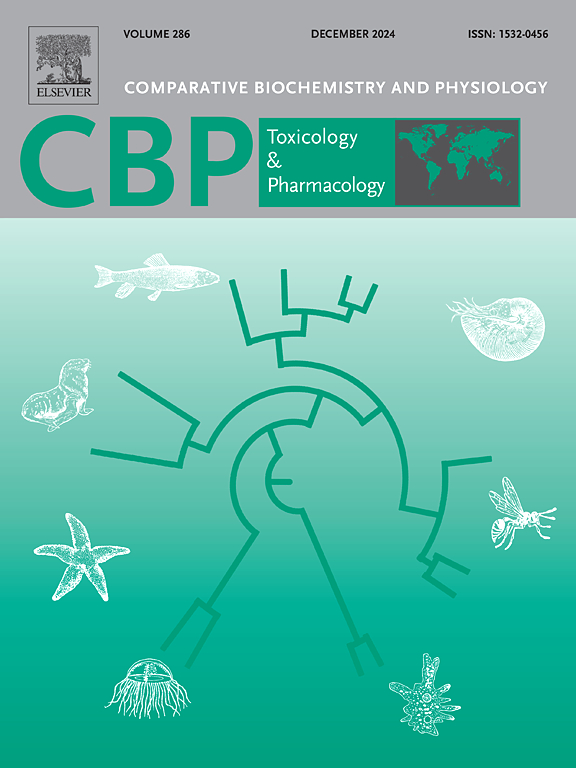Sublethal 6PPD-quinone exposure impairs swimming performance and aerobic metabolism in juvenile lake trout (Salvelinus namaycush)
IF 3.9
3区 环境科学与生态学
Q2 BIOCHEMISTRY & MOLECULAR BIOLOGY
Comparative Biochemistry and Physiology C-toxicology & Pharmacology
Pub Date : 2025-03-04
DOI:10.1016/j.cbpc.2025.110166
引用次数: 0
Abstract
6PPD-quinone, an environmental oxidation product of the rubber tire antioxidant 6PPD, has recently gained recognition as a chemical of concern. Frequently detected in road runoff and surface waters, studies have reported this compound to cause acute lethality in several salmonid species at extremely low concentrations, including lake trout (Salvelinus namaycush; 24-h LC50 = 0.51 μg/L). Following exposure, species experiencing acute lethality show characteristic symptoms such as gasping, spiraling, increased ventilation, loss of equilibrium, erratic movements, and tumbling. However, there is a deficit of research targeted at understanding sublethal toxicities of 6PPD-quinone exposure, particularly concerning swimming capability and metabolic function. To evaluate these effects, juvenile lake trout were exposed for 20 h to a measured concentration of 0.46 μg/L 6PPD-quinone in a swim tunnel respirometer to assess temporal changes in standard metabolic rate (SMR) compared to controls. Following exposure, fish underwent a swim trial to determine critical swimming speed (Ucrit), oxygen consumption rate (MO2), active metabolic rate (AMR), aerobic scope (AS) and energetic cost of transport (CoT), followed by analysis of muscle triglyceride and glycogen concentrations. Results showed that 6PPD-quinone exposure impaired swimming performance, evident by a decrease in Ucrit. Additionally, exposure resulted in decreased AMR, although alterations in SMR were not observed. Decreased concentrations of muscle triglycerides of swam fish were also observed. These findings suggest that environmentally relevant concentrations of 6PPD-quinone disrupt aerobic metabolic capacity in juvenile lake trout, producing adverse effects that diminish endurance and maximum swim speeds, which may affect survival of fish populations.

亚致死的6ppd -醌暴露会损害湖鳟鱼幼鱼的游泳性能和有氧代谢。
6PPD-醌是橡胶轮胎抗氧化剂6PPD的一种环境氧化产物,近年来引起了人们的关注。经常在道路径流和地表水中检测到这种化合物,研究报告说,这种化合物在极低浓度下会对几种鲑鱼物种造成急性致命,包括湖鳟鱼(Salvelinus namaycush;24小时LC50 = 0.51μg / L)。在接触后,经历急性致死的物种表现出特有的症状,如喘气、螺旋式上升、通气增加、失去平衡、不稳定的运动和翻滚。然而,针对6ppd -醌暴露的亚致死毒性,特别是与游泳能力和代谢功能有关的研究存在缺陷。为了评估这些影响,将湖鳟鱼幼鱼暴露在0.46 μg/L 6ppd -醌浓度下20 h,在游泳隧道呼吸计中评估与对照组相比,标准代谢率(SMR)的时间变化。暴露后,对鱼进行游泳试验,以确定临界游泳速度(Ucrit)、耗氧量(MO2)、活性代谢率(AMR)、有氧范围(AS)和能量运输成本(CoT),然后分析肌肉甘油三酯和糖原浓度。结果表明,6ppd -醌暴露会损害游泳成绩,明显表现为Ucrit下降。此外,暴露导致AMR降低,但未观察到SMR的变化。游动鱼的肌肉甘油三酯浓度也有所下降。这些发现表明,环境相关浓度的6ppd醌会破坏湖鳟鱼幼鱼的有氧代谢能力,产生不利影响,降低耐力和最大游泳速度,这可能会影响鱼类种群的生存。
本文章由计算机程序翻译,如有差异,请以英文原文为准。
求助全文
约1分钟内获得全文
求助全文
来源期刊
CiteScore
7.50
自引率
5.10%
发文量
206
审稿时长
30 days
期刊介绍:
Part C: Toxicology and Pharmacology. This journal is concerned with chemical and drug action at different levels of organization, biotransformation of xenobiotics, mechanisms of toxicity, including reactive oxygen species and carcinogenesis, endocrine disruptors, natural products chemistry, and signal transduction with a molecular approach to these fields.

 求助内容:
求助内容: 应助结果提醒方式:
应助结果提醒方式:


